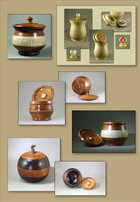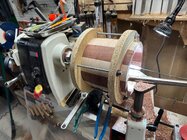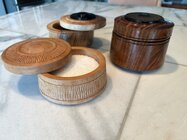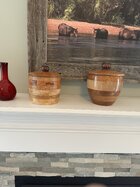I have two box rests, one from Robust and one from Best Wood Tools. They are SO useful at times. I also use several box scrapers made especially for straight sides.
However, an observation. I wonder if Beads Of Courage boxes are more useful to the kids if shorter and wide rather than tall and perhaps deeper straight-sided boxes. For one thing, squatter boxes might be easier to reach into go get out strings of beads.
By far, the easiest method I’ve used is an expansion on the way I saw Harvey Meyer turn them. He used two kiln-dried thick layers and another for the lid. I found that the proportions of three layers were better to my eye. For example, all those shown here except for the taller one made from a solid poplar blank (with a music box in the lid).

Looking at the one at the bottom left, it is walnut, and cherry. The three 2” thick sections are mostly pre-turned before they are glued together, leaving only a thin “web” on the top and middle ones, and turning inside of the bottom one before the glueup. Then I mount the stack and cut through the webs from the top. From there, finishing up the inside is FAR quicker and easier than hollowing out all that dry wood.
In fact, for one demo, I not only turned the bowl shape in the bottom but smoothed, sanded, and applied finish before the glue up. To start the demo I mounted the stack, quickly cut through the thin “webs” on the top to layers, then passed around the mostly hollowed piece with the bottom smooth and finished. Believe me, this saves a LOT of time and effort.
Also, I’ve gone to tapered fits on the lids after seeing a bunch of BOC boxes at a symposium with MOST of the lids were stuck. The guy at our club who took BOC boxes to the children’s hospital told me he had to fix the lids on about half of all those turned in. A tapered fit is easy for the kids to remove, falls into place when put back on the box, and can’t possibly stick.
Note that boxes made from lumber like this are almost always face grain and will undergo seasonal dimensional changes. The taper on the lid really helps with that.
In fact, I like the tapered fit so much I started using it on almost all turned boxes. I’ve banished the “woodturners bragging rights pop fit” from my shop except for little boxes meant to be carried in the pocket without risk of the lid coming off.
I never wrote a document on all this but I do have the simple drawings I used at demos and as handouts.
JKJ






